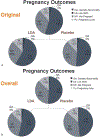The Effects of Aspirin in Gestation and Reproduction (EAGeR) Trial: A Story of Discovery
- PMID: 29036741
- PMCID: PMC6234510
- DOI: 10.1055/s-0037-1606384
The Effects of Aspirin in Gestation and Reproduction (EAGeR) Trial: A Story of Discovery
Abstract
Human reproduction is an inefficient process. There are several drivers of complications along the path to and during pregnancy, one of which is inflammation. Treatments to mitigate the deleterious effects of aberrant inflammation with something inexpensive and widely available like aspirin could have dramatic global impact. The Effects of Aspirin in Gestation and Reproduction (EAGeR) trial enrolled women aged 18 to 40 years with one to two prior pregnancy losses and no diagnosis of infertility. Patients were randomized to either low-dose aspirin or placebo. Here, we review the collective findings of the EAGeR trial to date and discuss several important lessons learned from the unique data resulting from this groundbreaking trial. Findings reported from this trial provide significant advances in the understanding of aspirin’s potential mechanisms in modulating reproductive processes and the role of inflammation in these processes. This review describes the collective findings of the EAGeR trial in the context of the existing literature regarding aspirin and inflammation in reproduction to inform relevant next steps in fertility and obstetric research, as well as potential implications for clinical care.
Conflict of interest statement
Conflict of Interest: The authors have no conflict of interest to disclose.
Figures




References
-
- Zinaman MJ, Clegg ED, Brown CC, O’Connor J, Selevan SG. Estimates of human fertility and pregnancy loss. Fertil Steril 1996; 65(03):503–509 - PubMed
-
- Wilcox AJ, Weinberg CR, O’Connor JF, et al. Incidence of early loss of pregnancy. N Engl J Med 1988;319(04):189–194 - PubMed
-
- Guttmacher AF. Factors affecting normal expectancy of conception. J Am Med Assoc 1956;161(09):855–860 - PubMed
-
- Wilcox AJ, Baird DD, Weinberg CR. Time of implantation of the conceptus and loss of pregnancy. N Engl J Med 1999;340(23): 1796–1799 - PubMed
-
- Risch HA, Weiss NS, Clarke EA, Miller AB. Risk factors for spontaneous abortion and its recurrence. Am J Epidemiol 1988;128(02): 420–430 - PubMed
Publication types
MeSH terms
Substances
Grants and funding
LinkOut - more resources
Full Text Sources
Other Literature Sources
Medical

